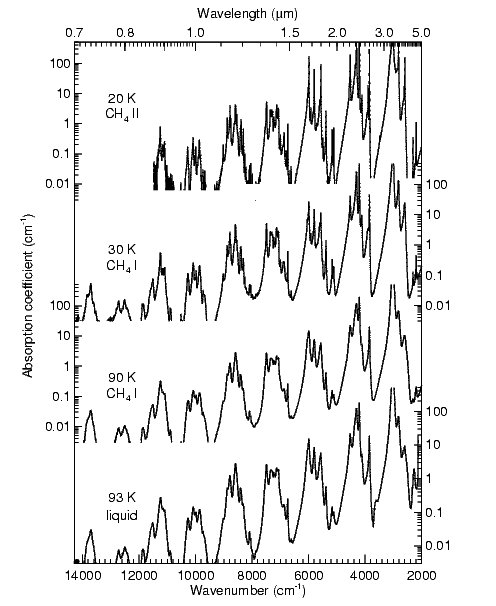
The Temperature-Dependent spectrum of methane ice I between 0.7 and 5 microns and opportunities for near-infrared remote thermometry
Published in 2002: Icarus 155, 486-496.
W.M. Grundy(1,4), B. Schmitt(2,4), and E. Quirico(2,3,4)
(1) Lowell Observatory, Flagstaff Arizona.
(2) Laboratoire de Planétologie de Grenoble, Grenoble, France.
(3) Formerly at Institute d'Astrophysique Spatiale, Orsay, France.
(4) Formerly at Laboratoire de Glaciologie at Géophysique de l'Environnement, St. Martin d'Hères, France.
Abstract
New infrared absorption coefficient spectra of pure methane ice I were measured at temperatures between 30 and 90 K, over wavelengths from 0.7 to 5 microns, along with spectra of methane ice II at 20 K and liquid methane at 93 K. The spectra were derived from transmission measurements through monocrystalline samples grown in a series of closed cells having interior dimensions ranging from 100 microns to 1 cm. The thicker samples permitted measurement of extremely weak absorption bands, with absorption coefficients as small as 0.003 cm-1. We report fourteen new absorption bands, which we tentatively assign to specific vibrational transitions. Two of the new bands are attributed to CH3D. Measurements of the weaker CH4 bands are particularly needed for interpreting spectral observations of Pluto and Triton, where a number of weak CH4 ice absorption bands have been observed. The data presented in this paper complement studies of spectral transmission by thin films of methane ice, which are most suitable for measuring the stronger absorption bands. Temperature-dependent spectral features revealed by the new data offer the opportunity to determine CH4 ice temperatures remotely, via near-infrared reflectance spectroscopy. This approach could prove particularly valuable for future spacecraft exploration of Pluto.
